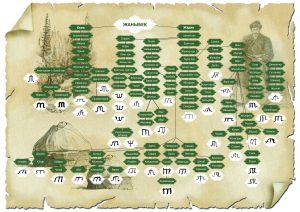




Scholars refer to the Turkic tamgas as “identification signs”, which originally played the role of legal signs for marking property (livestock, movable and immovable property, including wells, buildings, etc.). In addition, according to scholars [9], tamgas served as markers of domination and subjugation relationships and belonged to a special category of power symbols. Archaeologist A.E. Rogozhinsky believes that the tamga is a symbol of the identity of each person as a member of a certain collective, and its main channel of representation for contemporaries became rock art, various artefacts and even coins of ancient nomads. The existing and far from complete graphic fund of the Kazakh Tamghs is still poorly explored. From the point of view of the image, the Kazakh tamgh are abstract graphic signs in the form of the simplest figures: circle, cross, angle, and so on.Their careful study, including semantics, is a matter for the future.


